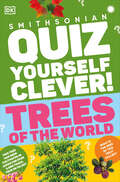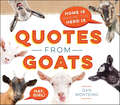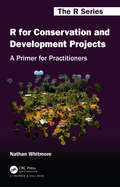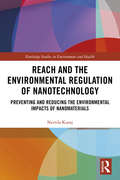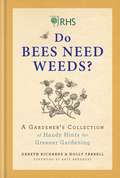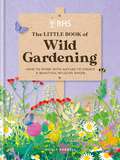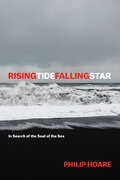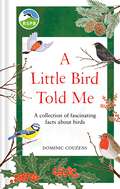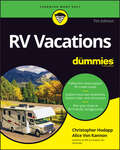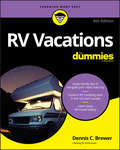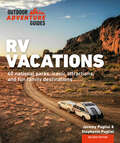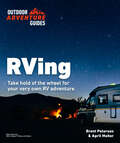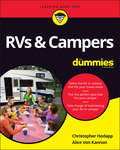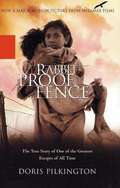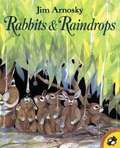- Table View
- List View
Quiz Yourself Clever! Trees of the World (DK Quiz Yourself Clever )
by DKDiscover the wonderful world of trees with this fact-packed quiz book!Explore the plant kingdom and meet more than 100 species of trees in this quiz book for children aged 9+, ranging from the mighty Californian redwood to the ancient banyan tree.Every tree is shown in beautiful detail, with quiz questions that will encourage engagement. Turn the page to find the answers to the questions - delivered in fast-fact style, including size, location, and distinguishing features - alongside close-up pictures of the bark, leaves, and fruit.This nature quiz book for children offers: - Fast and fun learning through the use of detailed tree images and interesting facts.- Hundreds of quick-fire questions for children to quiz themselves and challenge friends and family.- Information that has been endorsed and authenticated by experts and up-to-date nature knowledge.Vivid pictures and fast facts will allow children to gather a wealth of knowledge in a fun way! In no time, you'll be able to tell sycamore from silver birch, aspen from ash, and peach from plum. Discover the unique qualities of each tree, together with how it is used in art, industry, architecture, and science. For even more fun, get friends involved and quiz each other!More in the seriesIf you enjoyed Quiz Yourself Clever: Trees of the World, then why not test yourself with another quiz book to boost your knowledge? Try Quiz Yourself Clever: Rocks & Minerals and get to grips with fascinating rock and mineral forms, or Quiz Yourself Clever: Animals and learn about weird and wonderful species all over the world.
Quotes from Goats
by Dan MonteiroInspirational quotes and photos of adorable goatsGoats are the animal du jour – “goat yoga” (yoga with baby goats) has exploded in popularity, and social media is flooded with photos of cute kids. Quotes from Goats pairs irresistible photographs of everyone's favorite barnyard animal with inspiring quotations that resonate with both goats and humans, like:“The best view comes after the hardest climb.”"Never skip family dinner time!""Take a walk on the wild side."
R for Conservation and Development Projects: A Primer for Practitioners (Chapman & Hall/CRC The R Series)
by Nathan WhitmoreThis book is aimed at conservation and development practitioners who need to learn and use R in a part-time professional context. It gives people with a non-technical background a set of skills to graph, map, and model in R. It also provides background on data integration in project management and covers fundamental statistical concepts. The book aims to demystify R and give practitioners the confidence to use it. Key Features:• Viewing data science as part of a greater knowledge and decision making system • Foundation sections on inference, evidence, and data integration • Plain English explanations of R functions • Relatable examples which are typical of activities undertaken by conservation and development organisations in the developing world • Worked examples showing how data analysis can be incorporated into project reports
R. S. Thomas: Everyman Poetry
by rev R.S. ThomasA best of R.S. Thomas's poems in a beautiful new gift editionR. S. Thomas (1913- 2000) was born in Cardiff. He studied classics, then theology and, after ordination, served six rural Welsh parishes for most of his life. His first book of poems was published in 1946. He won the Queen's Gold Medal for Poetry in 1964 and published regularly, Collected Poems 1945-90 marking his eightieth birthday.
REACH and the Environmental Regulation of Nanotechnology: Preventing and Reducing the Environmental Impacts of Nanomaterials (Routledge Studies in Environment and Health)
by Nertila KurajREACH and the Environmental Regulation of Nanotechnology presents a thorough and comprehensive legal analysis on the status of nanoscale chemicals under the EU’s REACH (Registration, Evaluation, Authorisation, and Restriction) regulation, asking whether it effectively safeguards human health and environmental protection. This book examines the European Commission’s claim that REACH offers the best possible framework for the risk management of nanomaterials. Through a detailed and meticulous analysis of the four phases of REACH, Kuraj assesses the capacity of the Regulation to protect human health and the environment against the potential harms associated with exposure to nanomaterials, and draws attention to the ways in which the specificities of nanoscale chemicals are (not) tackled by the current REACH framework. Overall, this book is an innovative and timely contribution to the ongoing debate on how to best address the unprecedented risks posed by the growing pursuit of nanotechnological innovation by the EU and global policy agenda. REACH and the Environmental Regulation of Nanotechnology will be of great interest to advanced students and scholars of environmental law and policy, environmental governance, science and technology studies, and environment and health.
REFLEXIONES DE UN AMANTE DE LA NATURALEZA: Un Libro sobre la Caza del Ciervo y del Pavo
by Gustavo G. Zamora Chodorge Kevin Lee MciverREFLEXIONES DE UN AMANTE DE LA NATURALEZA: Un Libro sobre la Caza del Ciervo y del Pavo En la juventud, solíamos dudar de las maravillas del mundo hasta que atestiguábamos algo de primera mano. Recuerdo un verano en la granja de mis abuelos en la Missouri rural, cuando mis primos y yo estábamos inspeccionando nuestra última arma de elección, una nueva gomera de muñeca equipada con un potente tubo de goma de gran alcance y un mango que albergaba proyectiles esféricos de acero. Qué hermosura de arma era de observar, con su moderno armamento, en comparación con nuestro anterior modelo de madera que era raramente precisa. Nos la pasamos entre los tres, especulando que nada menos que un cañón obús podría igualarla. El sostener el mango evocaba visiones de abatir grandes presas como osos y leones, o de mantener una posición frente a hordas de soldados de infantería enemiga en avance. Mientras nos movíamos cerca del camino de tierra que lleva hacia el granero para poner a prueba nuestra gomera, vimos a nuestra presa asomándose. Aunque era un viejo pedazo de chapa vertical para techos apoyada a unos 27 metros, podría igualmente haber sido un elefante toro en el Serengueti.
RHS Botany for Gardeners: The Art and Science of Gardening Explained & Explored
by Royal Horticultural Society'Clever... valuable introduction to the study of plant science.' - Gardeners IllustratedRHS Botany for Gardeners is more than just a useful reference book on the science of botany and the language of horticulture - it is a practical, hands-on guide that will help gardeners understand how plants grow, what affects their performance, and how to get better results. Illustrated throughout with beautiful botanical prints and simple diagrams, RHS Botany for Gardeners provides easy-to-understand explanations of over 3,000 botanical words and terms, and show how these can be applied to everyday gardening practice. For easy navigation, the book is divided into thematic chapters covering everything from Plant Pests, and further subdivided into useful headings such as 'Seed Sowing' and 'Pruning'. 'Botany in Action' boxes provide instantly accessible practical tips and advice, and feature spreads profile the remarkable individuals who collected, studied and illustrated the plants that we grow today. Aided by this book, gardeners will unlock the wealth of information that lies within the intriguing world of botanical science - and their gardens will thrive as a result. This is the perfect gift for any gardener.Contents Includes...The Plant kingdomGrowth, Form and FunctionInner WorkingsReproductionThe Beginning of LifeExternal FactorsPruningBotany and the SensesPest, Diseases and DisordersBotanists and Botanical Illustration... And Much More!
RHS Colour Companion: A Visual Dictionary of Colour for Gardeners
by Dr Ross Bayton Richard SneesbyWhether you are planning a brand-new garden or looking for complementary plants to add to your existing one, RHS Colour Companion is an inspirational and highly practical sourcebook of ideas for incorporating colour into your garden.An introductory section explains the basics of colour in plants and how it can be harnessed, and colour-themed chapters then focus on each colour's uses in the garden. A gallery of garden elements for each colour then follows - from foliage and flowers to bark, fruit, berries and even hard landscaping materials. Each plant in the gallery is supported with cultivation guidance and suggestions for incorporating it into a planting plan for maximum impact.Advice is accompanied by tips for planting plans and photographs to help you visualize the finished effect.
RHS Do Bees Need Weeds: A Gardener's Collection of Handy Hints for Greener Gardening
by Holly Farrell Gareth RichardsRHS Do Bees Need Weeds is packed with more than 100 practical questions and answers to help you become a more eco-friendly gardener, and show you how to adopt a more sustainable way of gardening. The book includes simple, low-cost ideas, from fun projects such as how to build a wormery or a homemade water butt to advice on which plants suit bees best and how to achieve a zero-waste garden.In these pages you will find dozens of solutions to common garden problems as well as inspiring innovations that reduce your gardening consumption, tackle waste and help the environment. Filled with fascinating facts and ideas that will help you make a real difference to the green credentials of your garden, this book is both informative and entertaining, with plenty of I-never-knew-that mini-features. This is a book you and your family need, and one that you'll all enjoy, too.Includes questions such as:- Which features will make my garden greener?- Are my garden lights harmful?- How can a lawn be wildlife-friendly?- Is it ever OK to have a bonfire?- Are there alternatives to plastic?- Can I grow year-round crops?- Is it OK to buy compost?
RHS The Little Book of Wild Gardening: How to work with nature to create a beautiful wildlife haven
by Holly FarrellThe Little Book of Wild Gardening is a guide for anyone wanting to garden in a more sustainable, natural way. Working with nature benefits not just the garden, but also the gardener, wildlife and the wider environment. Divided into sections for different garden areas - including lawns, flower beds, edibles, trees and water features - The Little Book of Wild Gardening details how to embrace a natural approach to gardening for plots large and small.Introductory chapters explain how garden ecosystems can work, and how a healthy garden can mean savings in both work and resources for the gardener. There are plant profiles providing a variety of choices for a wilder approach, plus design tips and expertise in sustainable and wildlife-friendly gardening. From a sustainable veg patch to wildflower meadows, and from bat boxes to gravel gardens, the book includes projects and plants in a range of sizes and timescales so gardeners can create a bountiful and enjoyable haven that will benefit themselves, their local area, and all kinds of wildlife.
RHS The Little Book of Wild Gardening: How to work with nature to create a beautiful wildlife haven
by Holly FarrellThe Little Book of Wild Gardening is a guide for anyone wanting to garden in a more sustainable, natural way. Working with nature benefits not just the garden, but also the gardener, wildlife and the wider environment. Divided into sections for different garden areas - including lawns, flower beds, edibles, trees and water features - The Little Book of Wild Gardening details how to embrace a natural approach to gardening for plots large and small.Introductory chapters explain how garden ecosystems can work, and how a healthy garden can mean savings in both work and resources for the gardener. There are plant profiles providing a variety of choices for a wilder approach, plus design tips and expertise in sustainable and wildlife-friendly gardening. From a sustainable veg patch to wildflower meadows, and from bat boxes to gravel gardens, the book includes projects and plants in a range of sizes and timescales so gardeners can create a bountiful and enjoyable haven that will benefit themselves, their local area, and all kinds of wildlife.
RHS What to Grow for a Climate Resilient Garden: Practical advice for gardeners on plants that can cope in all climates
by Royal Horticultural Society Dr Amanda RasmussenAs the world's climate changes, this timely book from plant expert, Dr Amanda Rasmussen, explains what we should be planting in our outdoor spaces.What to Grow for a Climate Resilient Garden urges green-thumbed readers that are conscious of the environment to think deeper about the impact of maintaining a thriving garden on the future of the planet, and vice versa. With easy, practical ideas, it is the ideal book for experienced gardeners and a growing environmentally-inclined public looking for ways to make a difference.Eminent plant expert Dr Amanda Rasmussen explains what makes particular plants suited to certain conditions, along with easy-to-implement ideas for forward-thinking gardeners. Whether you are gardening in the rain, the baking hot sun, in the city or the countryside, you'll discover information and inspiration for creating your very own resilient garden.The author's expertise ensures a book that is botanically sound, but also aesthetically designed and eye-catching. The fascinating information about easy-to-find plants for a wide range of abilities and geographically diverse locations makes this book highly desirable for all gardeners wishing to diversify their green spaces as the climate continues to change radically.
RHS What to Grow for a Climate Resilient Garden: Practical advice for gardeners on plants that can cope in all climates
by Royal Horticultural Society Dr Amanda RasmussenAs the world's climate changes, this timely book from plant expert, Dr Amanda Rasmussen, explains what we should be planting in our outdoor spaces.What to Grow for a Climate Resilient Garden urges green-thumbed readers that are conscious of the environment to think deeper about the impact of maintaining a thriving garden on the future of the planet, and vice versa. With easy, practical ideas, it is the ideal book for experienced gardeners and a growing environmentally-inclined public looking for ways to make a difference.Eminent plant expert Dr Amanda Rasmussen explains what makes particular plants suited to certain conditions, along with easy-to-implement ideas for forward-thinking gardeners. Whether you are gardening in the rain, the baking hot sun, in the city or the countryside, you'll discover information and inspiration for creating your very own resilient garden.The author's expertise ensures a book that is botanically sound, but also aesthetically designed and eye-catching. The fascinating information about easy-to-find plants for a wide range of abilities and geographically diverse locations makes this book highly desirable for all gardeners wishing to diversify their green spaces as the climate continues to change radically.
RISINGTIDEFALLINGSTAR: In Search of the Soul of the Sea
by Philip Hoare“Every day is an anxiety in my ways of getting to the water. . . . I’ve become so attuned to it, so scared of it, so in love with it that sometimes I can only think by the sea. It is the only place I feel at home.” Many of us visit the sea. Admire it. Even profess to love it. But very few of us live it. Philip Hoare does. He swims in the sea every day, either off the coast of his native Southampton or his adopted Cape Cod. He watches its daily and seasonal changes. He collects and communes with the wrack—both dead and never living—that it throws up on the shingle. He thinks with, at, through the sea. All of which should prepare readers: RISINGTIDEFALLINGSTAR is no ordinary book. It mounts no straight-ahead argument. It hews to no single genre. Instead, like the sea itself, it moves, flows, absorbs, transforms. In its pages we find passages of beautiful nature and travel writing, lyrical memoir, seams of American and English history and much more. We find Thoreau and Melville, Bowie and Byron, John Waters and Virginia Woolf, all linked through a certain refusal to be contained, to be strictly defined—an openness to discovery and change. Running throughout is an air of elegy, a reminder that the sea is an ending, a repository of lost ships, lost people, lost ways of being. It is where we came from; for Hoare, it is where he is going. “Every swim is a little death,” Hoare writes, “but it is also a reminder that you are alive.” Few books have ever made that knife’s edge so palpable. Read RISINGTIDEFALLINGSTAR. Let it settle into the seabed of your soul. You’ll never forget it.
RSPB A Little Bird Told Me: A collection of fascinating facts about birds
by Dominic Couzens RSPBThe perfect, fun-filled Christmas gift for birdwatching enthusiastsDid you know that a bird's visible 'knees' are actually its ankles?Have you ever noticed that owls don't have eyeballs - they have eye tubes instead?Did you know that millions of house martins disappear in winter? A Little Bird Told Me will answer all your burning questions about British birds. You'll never run out of wonderful facts to impress your friends and family!This beautiful, illustrated gift book is a dip-in-and-out collection of bird-related trivia, with a mix of science, history, pop culture and everything in between.The book covers birds synonymous with Christmas, activities in the winter, holiday traditions, history, culture and more. Perfect for birdwatchers of all ages, this fun-filled book is the best gift for anyone wanting to learn more about our feathered friends.
RV Hacks: 400+ Ways to Make Life on the Road Easier, Safer, and More Fun! (Hacks)
by Marc Bennett Julie BennettHit the road and experience the wonders of RVing with these useful tips and tricks to make RV life easier, more organized, more efficient, and fun!Welcome to RV life! Whether you&’re a first-timer or an experienced RVer, these RV hacks are sure to make life on the road easier so you can worry less and have more fun. From ingenious organizational hacks (like broom holders to keep flashlights at the ready or suction cup shower organizers to corral kids&’ activity supplies) to ideas for repurposing plastic bottles to make a funnel or pancake batter mixer, RV Hacks has everything you need to make your next cross-country caravanning adventure carefree.
RV Vacations For Dummies
by Christopher Hodapp Alice Von KannonHit the open road with help from expert travelers Keep RV Vacations For Dummies by your side as you navigate the highways of the United States and Canada. (But don’t read and drive.) This Dummies guide will clue you into the most RV-ready roads, camp sites, and attractions to make planning your journey a bit easier. Choose from journeys through New England, the American heartland, the Rocky Mountains, Alaska via Canada, or any of the dozen other adventures detailed in this book. Get to know the can't-miss tourist attractions and the best places to park while you enjoy time off the road. This updated edition features all-new maps of the RV-friendliest routes out there, plus the latest on post-pandemic destinations. Ready, set, RV! Learn the art of planning an RV vacation that won’t wear you out Hook up your RV at campsites and explore local attractions Find a list of popular RV routes and cool places to visit Be prepared for mechanical issues and other hiccups in your travel plansThis Dummies guide is a must for RV owners and RV renters in need of guidance on well-planned travel routes, campground destinations, and attractions.
RV Vacations For Dummies
by Dennis C. BrewerGet ready to take your vacation on the road! Vacations go by in a flash. With all the frantic travel arrangements, hotels bookings, and racing from place to place, it’s a wonder they’re considered a vacation at all! A great way to slow down and fully experience the sights is to hit the open road from the comfort of an RV. In this fully accessible book, you’ll find the basics of what you need to know to get the most out of your RV vacation experience, including how to buy or rent an RV, safety best practices, and tips and tricks for planning the trip of your dreams. If you are planning a summer long adventure or simply a short weekend getaway, with this book you will discover proven ideas to keep your trip on track. Even if you’ve never vacationed on wheels, you’ll get a handle on the latest functions of RVs and the hottest RV vacation destinations. Whether you beach it, climb a mountain, or anything in between, the handy checklists and reminders inside help you to stay on course and rev up the best vacation you’ve ever had! Choose your RV Pick a great vacation destination What to know before you go Decide what items to bring Outline your route and outfit your vehicle Building an on-the-road budget Whether you want to rent or buy, an epic RV vacation is at your fingertips!
RV Vacations: Explore National Parks, Iconic Attractions, and 40 Memorable Destinations
by Stephanie Puglisi Jeremy PuglisiExplore America from your RVWhat could be better than hitting the road in an RV and seeing the best of what the United States has to offer with your family? Packed with 40 exciting trips you can enjoy from your home on wheels, this helpful guide gives you everything you need to plan the perfect RV vacation to great destinations like: • The Grand Canyon• Mount Rushmore• Niagara Falls• New Orleans• New York City• Rocky Mountain National Park• Walt Disney World• Yosemite National Park In this newly updated guide you'll discover: • 40 RV adventures for couples, families, and retirees.• Terrific trips to national parks, iconic attractions, and fun family destinations.• Expert recommendations for 120 campgrounds, from rustic to resort.• Delicious local dining options highlighting the best each area has to offer.• Insider information on must-see attractions and suggestions for 1-, 2-, and 3-week itineraries.
RVing, 4E (Outdoor Adventure Guide)
by Brent Peterson April MaherTake the driver's seat on your very own RV adventures!Take hold of the wheel and get ready for your very own RV adventure!Do you dream of living a life of adventure on the road? When you travel in an RV, you can enjoy all the comforts and conveniences of home, while exploring the great outdoors.Whether you're looking for the ultimate family vacation or thinking of downsizing and taking your life on the road, RVing, 4th edition will give you everything you need to make your dream a reality. From stocking your rig, to mapping your routes and planning your stops, you'll get everything you need to plan the ultimate family vacation and hit the road. Fully stocked with suggestions and advice for unforgettable RV adventures, this handy guide gives you everything you need to know for safe and successful RVing. In it you get: * Practical tips for renting or buying an RV, with tips for taking successful test-drives, negotiating price and options, and obtaining insurance * Expert advice for planning the perfect trip, including planning routes, choosing campgrounds, stocking your RV, and even boondocking * A primer on operating and maintaining your rig's electrical, plumbing, and LP systems * Troubleshooting tips for dealing with bad weather, accidents, breakdowns, and other pitfalls
RVs & Campers For Dummies
by Christopher Hodapp Alice Von KannonMake yourself at home on the road Live down by the beach one week and way up in the mountains the next? It sounds like an impossible dream, but motor-homers do it all the time. Whatever draws you to the mobile life—adventurous domestic vacations or permanently itchy feet—RVs & Campers For Dummies helps you feel right at home. The book explores the key aspects of glamping-with-wheels. Discover how it’s possible to bring beauty spots right to your doorstep without sacrificing domestic comforts like a comfy bed, private bathroom, and wholesome, healthy home cooking! In a down-home, friendly style, mobile-living veterans and husband-and-wife team Christopher Hodapp and Alice Von Kannon welcome you inside to discover everything from deciding to rent or buy the vehicle that best suits your needs to planning and prepping your first journey and then setting yourself up wherever you arrive at the perfect spot. Along the way you’ll learn how to adapt your driving skills to pilot your home on the road, as well as how to keep every aspect of it shipshape and ready for action. Explore your RV and camper options Stock up with the right supplies Get a snapshot of the mobile home lifestyle Troubleshoot common problems Getting there is half the fun—and this guide shows you how to do it safely and in style. So, buckle up (or relax in the back) … it’s going to be a wild but incredibly comfortable ride!
Rabbit Breeds: The Pocket Guide to 49 Essential Breeds
by Lynn M. StoneRabbits are the third-most popular pet in the United States and have also earned significant farming and commercial followings: fiber enthusiasts love angora for its light-weight warmth, and chefs are serving up increasing amounts of their high-protein, low-fat meat. In Rabbit Breeds, photographer Lynn M. Stone spotlights all 49 breeds recognized by the American Rabbit Breeders Association with adorable original photos, engaging descriptions, and fun facts. This handsome and educational guide is sure to inform and bring a smile to the face of rabbit fanciers and general animal lovers alike.
Rabbit-Proof Fence
by Doris Pilkington Nugi GarimaraTHE REMARKABLE TRUE STORY OF THREE YOUNG GIRLS WHO CROSS THE HARSH AUSTRALIAN DESERT ON FOOT TO RETURN TO THEIR HOME. Following an Australian government edict in 1931, black aboriginal children and children of mixed marriages were gathered up by whites and taken to settlements to be assimilated. In Rabbit-Proof Fence, award-winning author Doris Pilkington traces the captivating story of her mother, Molly, one of three young girls uprooted from her community in Southwestern Australia and taken to the Moore River Native Settlement. At the settlement, Molly and her relatives Gracie and Daisy were forbidden to speak their native language, forced to abandon their aboriginal heritage, and taught to be culturally white. After regular stays in solitary confinement, the three girls-scared and homesick-planned and executed a daring escape from the grim camp, with its harsh life of padlocks, barred windows, and hard cold beds. The girls headed for the nearby rabbit-proof fence that stretched over 1000 miles through the desert toward their home. Their journey lasted over a month, and they survived on everything from emus to feral cats, while narrowly avoiding the police, professional trackers, and hostile white settlers. Their story is a truly moving tale of defiance and resilience.
Rabbits And Raindrops
by Jim ArnoskyIt's the first day outside the nest for Mother rabbit's five babies, and all sorts of new creatures and adventures await them. But when a sudden rain shower sends the rabbits scurrying for shelter under the hedge, the other wild animals come to visit them! Jim Arnosky's graceful watercolors and simple text are sure to delight children experiencing nature's wonders for the first time.
Rabbits: The Animal Answer Guide (The Animal Answer Guides: Q&A for the Curious Naturalist)
by John Seidensticker Susan LumpkinDid you know that there are more than 90 species of rabbits, hares, and pikas, rabbits' little-known cousins? And that new species are still being found? Or that baby rabbits nurse from their mothers only once a day? How about that some people brew medicinal tea from rabbit pellets? Wildlife conservationists Susan Lumpkin and John Seidensticker have all the answers—from the mundane to the unbelievable—about the world’s leaping lagomorphs. To some, rabbits are simply a docile pet for the classroom or home. To others, they are the cute animals munching on clover or the pests plaguing vegetable gardens. Whatever your interest, in Rabbits: The Animal Answer Guide you will discover that they are a more complex group than you might have first imagined. Lumpkin and Seidensticker take these floppy-eared creatures out of the cabbage patch and into the wild, answering 95 frequently asked questions about these familiar and fascinating animals.With informative photographs and an accessible format, Rabbits: The Animal Answer Guide is the one resource you will need to learn about rabbits' anatomy and physiology, evolutionary history, ecology, behavior, and their relationships with humans. Lumpkin and Seidensticker also talk about conservation, because while rabbits may breed like, well, rabbits, several species are among the most endangered animals on Earth.
